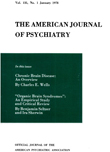THE ELECTROENCEPHALOGRAM IN POST-TRAUMATIC EPILEPSY
Abstract
The electroencephalograms of 175 cases of post-traumatic epilepsy and of 215 cases of head injury without epilepsy were compared. The group of head injury patients without epilepsy was subdivided into 113 cases of mild injury and 102 cases of severe injury. In all cases the electroencephalogram was taken three months or more after the injury so that only the chronic post-traumatic state was considered.
Comparisons were made between the electroencephalograms of these three post-traumatic groups, a group of 1,161 unselected epileptics and a group of 1,000 normal control subjects.
On the basis of differences between the five groups, the following conclusions are drawn with regard to the electroencephalogram in the chronic post-traumatic state:
1. Among patients with severe head injuries but no seizures, the incidence of abnormal electroencephalograms continues to decrease from three months to two years after injury.
2. Among post-traumatic epileptics, there is a relatively slight decrease in the incidence of abnormalities from three months to two years after injury.
3. Mild head injuries do not greatly increase the incidence of abnormal electroencephalograms above the level encountered in the normal control series.
4. In severe head injuries without seizures, the incidence of electroencephalographic abnormalities is more than twice as high as in the normal control group.
5. After head injury, children are slightly more likely to show abnormalities than adults. They are especially likely to show focal abnormalities.
6. Focal electroencephalographic abnormality is four times as common in post-traumatic epileptics as in unselected epileptics.
7. Focal electroencephalographic abnormality correlates with focal seizures. It strongly suggests localized brain damage.
8. Focal paroxysmal electroencephalograms, i. e., those manifesting focal seizure-discharges, are twenty-one times as common among post-traumatic epileptics as among head injury patients without seizures.
9. Subjective complaints after head injury do not correlate significantly with electroencephalographic abnormalities.
Access content
To read the fulltext, please use one of the options below to sign in or purchase access.- Personal login
- Institutional Login
- Sign in via OpenAthens
- Register for access
-
Please login/register if you wish to pair your device and check access availability.
Not a subscriber?
PsychiatryOnline subscription options offer access to the DSM-5 library, books, journals, CME, and patient resources. This all-in-one virtual library provides psychiatrists and mental health professionals with key resources for diagnosis, treatment, research, and professional development.
Need more help? PsychiatryOnline Customer Service may be reached by emailing [email protected] or by calling 800-368-5777 (in the U.S.) or 703-907-7322 (outside the U.S.).



